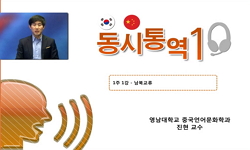Background and Objectives: Tinnitus is characterized as a perception of numerous auditorysounds in absence of external stimulus. Tinnitus can have a considerable consequence ona person’s quality of life, and is considered to be very complicated to q...
http://chineseinput.net/에서 pinyin(병음)방식으로 중국어를 변환할 수 있습니다.
변환된 중국어를 복사하여 사용하시면 됩니다.
- 中文 을 입력하시려면 zhongwen을 입력하시고 space를누르시면됩니다.
- 北京 을 입력하시려면 beijing을 입력하시고 space를 누르시면 됩니다.
https://www.riss.kr/link?id=A104840305
-
저자
Muhammad Aqeel (Foundation University Islamabad) ; Ammar Ahmed (Foundation University Islamabad)

- 발행기관
- 학술지명
- 권호사항
-
발행연도
2018
-
작성언어
English
- 주제어
-
등재정보
KCI등재,SCOPUS,ESCI
-
자료형태
학술저널
-
수록면
13-19(7쪽)
-
KCI 피인용횟수
0
- 제공처
- 소장기관
-
0
상세조회 -
0
다운로드
부가정보
다국어 초록 (Multilingual Abstract)
Background and Objectives: Tinnitus is characterized as a perception of numerous auditorysounds in absence of external stimulus. Tinnitus can have a considerable consequence ona person’s quality of life, and is considered to be very complicated to quantify. The aim of thisstudy was to investigate the reliability and validity of Urdu translation of the Tinnitus HandicapInventory (THI) in Pakistan. It was designed to assess the presence of various auditorysounds without the external stimulus. Scale consisted of 25 items having three subscalesfunctional, emotional, and catastrophic. Subjects and Methods: The study comprised intotwo stages, preliminary and main studies. The results of preliminary study revealed that theoverall scale had high internal consistency [alpha coefficient of Urdu version of THI (THIU)=0.99, alpha coefficient of English version of THI=0.98]. The overall scale had test-retestcorrelation over a fifteen days period of interval (0.99). Main study was performed on 110tinnitus patients. The results of main study showed that the internal consistency and reliabilityof Urdu version was (α=0.93). The THI-U and its subscales demonstrated good internalconsistency reliability ( α =0.81 to 0.86). Results: High to moderate correlations werenoted between tinnitus symptom ratings. A confirmatory factor analysis was used to validatethe three subscales of THI-U, and high inter-correlations were found between thesubscales also results revealed that a three-factor model for the THI-U was most tenable.
The results displayed that the confirmatory factor analysis confirmed to validate the threesubscales of THI-U. Conclusion: THI-U might present important information about precisefacets of tinnitus distress along with diagnostic interviews in clinical practice.
참고문헌 (Reference)
1 Monzani D, "Validity of the Italian adaptation of the Tinnitus Handicap Inventory; focus on quality of life and psychological distress in tinnitus-sufferers" 28 : 126-134, 2008
2 Kleinjung T, "Validation of the German-version Tinnitus Handicap Inventory" 34 (34): S140-S142, 2007
3 Tabachnick BG, "Using multivariate statistics" Allyn and Bacon 2001
4 Brislin RW, "Translation: applications and research" Gardner Press 1976
5 한병인, "Tinnitus: Characteristics, Causes, Mechanisms, and Treatments" 대한신경과학회 5 (5): 11-19, 2009
6 Habets B, "The complete guide to tinnitus: a practical guide to understanding and treating tinnitus" Carnell 1995
7 Aksoy S, "The Tinnitus Handicap Inventory: a study of validity and reliability" 13 : 94-98, 2007
8 Lee So Young, "Roles of Cognitive Characteristics in Tinnitus Patients" 대한의학회 19 (19): 864-869, 2004
9 Zachariae R, "Reliability and validity of a Danish adaptation of the Tinnitus Handicap Inventory" 29 : 37-43, 2000
10 Zhaoli Meng, "Reliability and Validity of the Chinese (Mandarin) Tinnitus Handicap Inventory" 대한이비인후과학회 5 (5): 10-17, 2012
1 Monzani D, "Validity of the Italian adaptation of the Tinnitus Handicap Inventory; focus on quality of life and psychological distress in tinnitus-sufferers" 28 : 126-134, 2008
2 Kleinjung T, "Validation of the German-version Tinnitus Handicap Inventory" 34 (34): S140-S142, 2007
3 Tabachnick BG, "Using multivariate statistics" Allyn and Bacon 2001
4 Brislin RW, "Translation: applications and research" Gardner Press 1976
5 한병인, "Tinnitus: Characteristics, Causes, Mechanisms, and Treatments" 대한신경과학회 5 (5): 11-19, 2009
6 Habets B, "The complete guide to tinnitus: a practical guide to understanding and treating tinnitus" Carnell 1995
7 Aksoy S, "The Tinnitus Handicap Inventory: a study of validity and reliability" 13 : 94-98, 2007
8 Lee So Young, "Roles of Cognitive Characteristics in Tinnitus Patients" 대한의학회 19 (19): 864-869, 2004
9 Zachariae R, "Reliability and validity of a Danish adaptation of the Tinnitus Handicap Inventory" 29 : 37-43, 2000
10 Zhaoli Meng, "Reliability and Validity of the Chinese (Mandarin) Tinnitus Handicap Inventory" 대한이비인후과학회 5 (5): 10-17, 2012
11 Jalali MM, "Psychometric properties of the Persian version of the Tinnitus Handicap Inventory (THI-P)" 27 : 83-94, 2015
12 Kam AC, "Psychometric properties of the Chinese (Cantonese) Tinnitus Handicap Inventory" 34 : 309-315, 2009
13 Ghulyan-Bedikian V, "Psychometric properties of a French adaptation of the Tinnitus Handicap Inventory" 36 : 390-396, 2010
14 Newman CW, "Psychometric adequacy of the Tinnitus Handicap Inventory (THI) for evaluating treatment outcome" 9 : 153-160, 1998
15 Shargorodsky J, "Prevalence and characteristics of tinnitus among US adults" 123 : 711-718, 2010
16 Sardar S, "Optical character recognition system for Urdu" IEEE 2010
17 Herraiz C, "Handicap evaluation in tinnitus patients" 52 : 534-538, 2001
18 Hambleton RK, "Guidelines for adapting educational and psychological tests: a progress report" 10 : 229-244, 1994
19 Baguley DM, "Factor analysis of the Tinnitus Handicap Inventory" 12 : 31-34, 2003
20 Urbina S, "Essentials of psychological testing" John C Wiley & Sons, Inc 2004
21 Crummer RW, "Diagnostic approach to tinnitus" 69 : 120-126, 2004
22 Newman CW, "Development of the Tinnitus Handicap Inventory" 122 : 143-148, 1996
23 Zacharia T, "Development and standardization of Tinnitus Handicap Inventory in Kannada" 17 : 117-123, 2012
24 Schmidt LP, "Brazilian Portuguese language version of the "Tinnitus Handicap Inventory": validity and reproducibility" 72 : 808-810, 2006
25 Osborne JW, "Best practices in quantitative methods" SAGE Publications, Inc 2008
26 Kleinstauber M, "A confirmatory factor analytic validation of the Tinnitus Handicap Inventory" 78 : 277-284, 2015
27 Oron Y, "A Hebrew adaptation of the Tinnitus Handicap Inventory" 50 : 426-430, 2011
동일학술지(권/호) 다른 논문
-
A Case of Medullary Infarction Presented Initial Symptoms Similar to Meniere’s Disease
- 대한청각학회
- 박장희
- 2018
- KCI등재,SCOPUS,ESCI
-
The Light Cupula: An Emerging New Concept for Positional Vertigo
- 대한청각학회
- 김민범
- 2018
- KCI등재,SCOPUS,ESCI
-
Can A Sudden Sensorineural Hearing Loss Occur Due to Miliary Tuberculosis?
- 대한청각학회
- 민상기
- 2018
- KCI등재,SCOPUS,ESCI
-
Role of Emotional Distress in Prolongation of Dizziness: A Cross-Sectional Study
- 대한청각학회
- 노경진
- 2018
- KCI등재,SCOPUS,ESCI
분석정보
인용정보 인용지수 설명보기
학술지 이력
| 연월일 | 이력구분 | 이력상세 | 등재구분 |
|---|---|---|---|
| 2023 | 평가예정 | 해외DB학술지평가 신청대상 (해외등재 학술지 평가) | |
| 2020-01-01 | 평가 | 등재학술지 유지 (해외등재 학술지 평가) |  |
| 2015-05-22 | 학술지명변경 | 한글명 : korean journal of audiology -> Journal of Audiology & Otology |  |
| 2013-10-01 | 평가 | 등재학술지 선정 (기타) |  |
| 2011-01-01 | 평가 | SCOPUS 등재 (기타) |  |
학술지 인용정보
| 기준연도 | WOS-KCI 통합IF(2년) | KCIF(2년) | KCIF(3년) |
|---|---|---|---|
| 2016 | 0.19 | 0.19 | 0.13 |
| KCIF(4년) | KCIF(5년) | 중심성지수(3년) | 즉시성지수 |
| 0.12 | 0.12 | 0.369 | 0 |





 KCI
KCI






